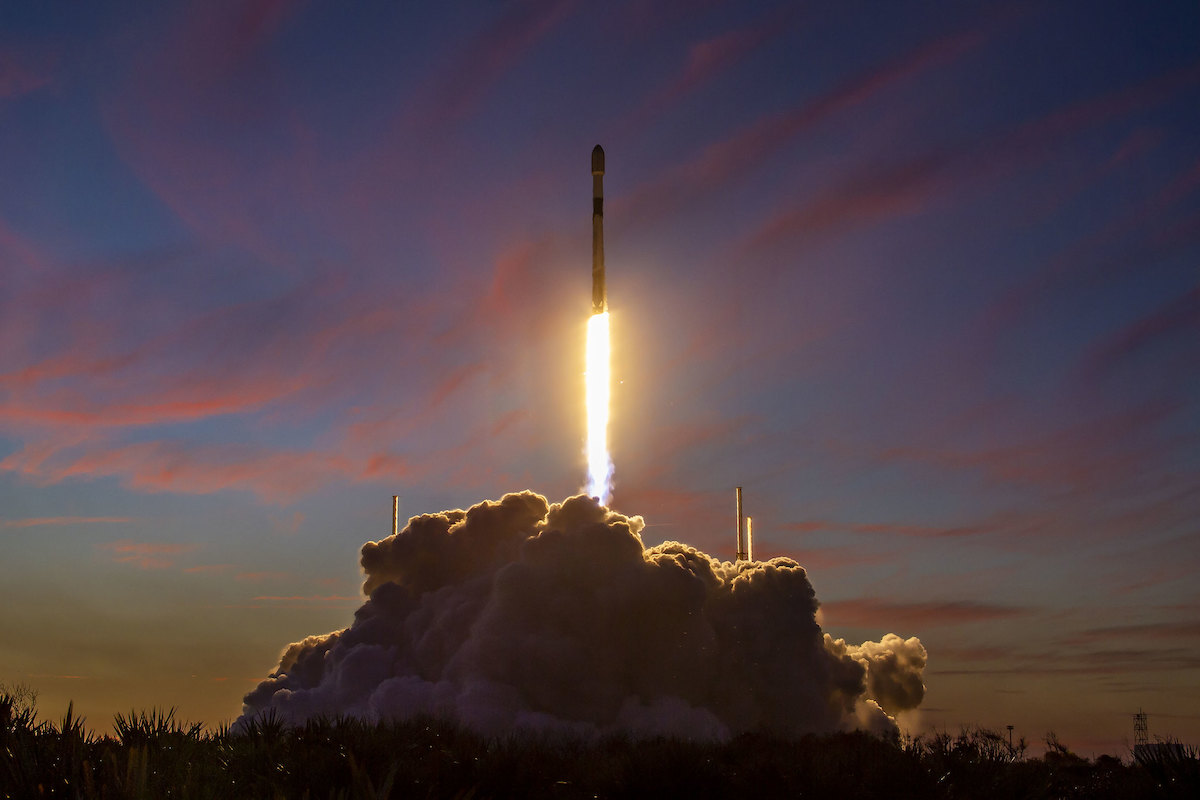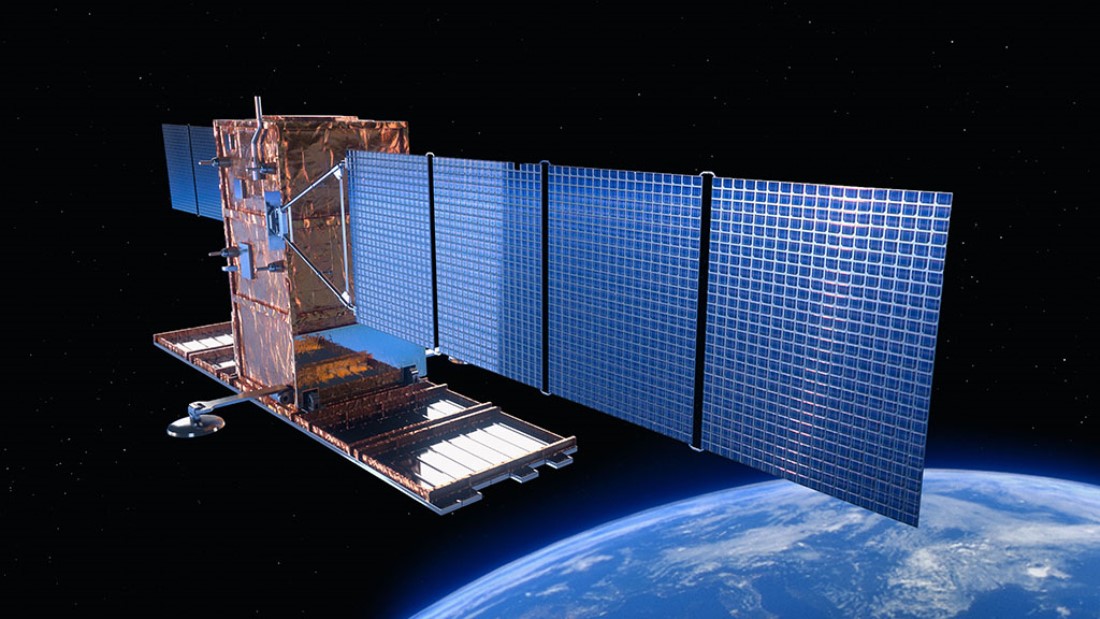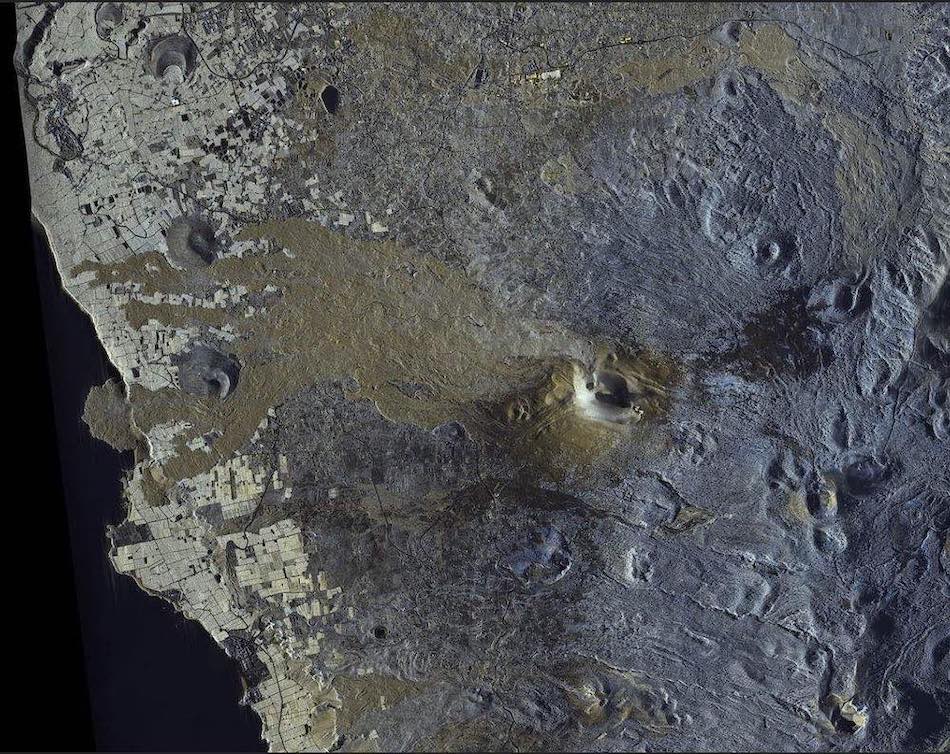
SpaceX gave an Italian radar satellite a picture-perfect ride into orbit with a memorable Monday evening launch from Cape Canaveral on top of a Falcon 9 rocket. A clear sunset sky offered spectators dazzling views of the reusable booster’s fiery climb into space and pyrotechnic plunge back to Earth.
Variables outside SpaceX’s control kept the Falcon 9 rocket and Italy’s newest COSMO-SkyMed radar remote sensing satellite on the ground four straight days. Bad weather prevented launch Thursday, Friday, and Saturday, then a cruise ship leaving Port Canaveral strayed into a hazard area south of the spaceport Sunday, causing range safety officials to call a hold.
But it all came together Monday, with a cloudless sky, a smooth countdown, and a clear range.
The 229-foot-tall Falcon 9 rocket fired away from pad 40 at Cape Canaveral Space Force Station at 6:11:14 p.m. EST (2311:14 GMT), about 10 minutes after sunset. Nine Merlin engines, burning rocket-grade kerosene fuel, spooled up to full power, putting out 1.7 million pounds of thrust to propel the Falcon 9 rocket through the atmosphere.
After exceeding the speed of sound, the Falcon 9 climbed into sunlight and began an arc toward the south-southeast. The rocket’s nine main engines shut off more than two minutes into the mission, and the booster stage jettisoned moments later. The Falcon 9’s second stage, powered by a single Merlin engine, ignited to continue accelerating the Italian radar satellite into orbit.
The first stage, itself more than 15 stories tall, cartwheeled at the edge of space to fly tail first, then reignited three of its engines for a burn to boost itself back toward Cape Canaveral. The incandescent exhaust plumes from both rocket stages were easily visible high overhead Florida’s Space Coast, appearing like a cosmic nebula in illuminated by the setting sun.
Spectators in Central Florida were treated to gorgeous views of SpaceX’s Falcon 9 rocket launch & landing this evening.
This shows the first stage beginning its boost-back burn to return to Cape Canaveral. The upper stage is flying downrange into orbit.https://t.co/C832PpxbqR pic.twitter.com/f1eBKwXIag
— Spaceflight Now (@SpaceflightNow) January 31, 2022
The booster fired three of its engines again for a supersonic re-entry burn, then fired its center engine to slow down for landing. Twin sonic booms shot across the Florida spaceport as the rocket descended toward Landing Zone 1, SpaceX’s rocket recovery site about 6 miles (9 kilometers) south of pad 40.
The on-target landing put an exclamation point on the booster’s third trip to space. SpaceX converted the rocket, designated B1052 in the company’s inventory, from previous use as a side booster on two Falcon Heavy rocket missions in 2019.
Technicians removed the rocket’s nose cone, connecting struts, and other specific hardware for the Falcon Heavy configuration, which is made by combining three Falcon rocket cores into one heavy-lift vehicle. SpaceX added an interstage adapter for the booster’s new role as a Falcon 9 first stage.
The flight marked the first time SpaceX has reconfigured a Falcon Heavy side booster into a single-stick Falcon 9 rocket. SpaceX previous converted two Falcon 9 boosters for use as side boosters on the first Falcon Heavy test flight in 2018.
The Falcon 9 rocket’s upper stage, meanwhile, fired its Merlin engine more than six minutes to place Italy’s COSMO-SkyMed radar satellite into a parking orbit. The launcher’s payload shroud separated from the rocket after reaching space nearly four minutes after liftoff.

The upper stage vectored thrust from its main engine to make a right turn, or “dogleg” maneuver, to veer the rocket south along Florida’s east coast, then over Cuba and the Caribbean Sea. The mission was the fifth SpaceX launch to use the southerly launch corridor from Cape Canaveral into polar orbit, a trajectory unused from 1969 until 2020.
The rocket soared over Antarctica and then headed north over the Indian Ocean, setting up for a brief restart of its engine to inject the COSMO-SkyMed radar satellite into the proper orbit. The spacecraft, with a launch mass of about 2.2 metric tons (4,850 pounds), separated from the Falcon 9 upper stage an hour after liftoff at an altitude of 392 miles (631 kilometers).
The satellite is the second in a new generation of COSMO-SkyMed radar imaging spacecraft. The fleet is intended for military and civilian use, and is funded by the Italian Space Agency, the Italian Ministry of Defense and the Italian Ministry of Universities and Research.
Each COSMO-SkyMed Second Generation, or CSG, spacecraft, is built by Thales Alenia Space. The satellite carries a radar instrument designed to observe Earth during day and night passes. After deploying from SpaceX’s Falcon 9 rocket, the CSG 2 satellite was expected to unfold its solar arrays and X-band radar antenna on its first day in space.
Thales Alenia Space confirmed in a press release early Tuesday that ground controllers in Fucino, Italy, established communication with the CSG 2 satellite about 15 minutes after separation from the Falcon 9 rocket.
The satellite is capable of capturing colorized synthetic aperture radar images with a horizontal resolution as good as 1 foot, or 30 centimeters. The highest-resolution images are restricted for use by institutions approved by the Italian government.
The COSMO-SkyMed satellites were “conceived from the very beginning of the project to satisfy both military and civil requests,” said Giancarlo Varacalli, head of engineering at the Italian Space Agency, known by the acronym ASI.
The second generation of Italian radar observation satellites will expand, and eventually replace, coverage provided by four first-generation COSMO-SkyMed spacecraft launched aboard United Launch Alliance Delta 2 rockets from 2007 through 2010.

The Italian government has ordered four second-generation COSMO-SkyMed satellites from Thales. The first of the new series of radar satellites launched in December 2019 aboard a Russian Soyuz rocket from French Guiana.
The second CSG satellite was originally booked with Arianespace to launch on a European Vega C rocket. But delays in the development of the Vega C, an uprated version of the Vega launcher, have pushed back the new rocket’s debut to no earlier than May.
The Vega C would not be able to launch the CSG 2 satellite until later this year, following the Vega C’s inaugural mission. That prompted Italian officials to look for a new ride, eventually resulting in their selection of SpaceX’s Falcon 9 rocket after Arianespace was unable to accommodate the CSG 2 launch.
Instead of launching the CSG 2 satellite, a Vega C rocket will instead launch the third spacecraft in the COSMO-SkyMed Second Generation fleet in 2024, according to ASI.
Featuring X-band synthetic aperture radars, the COSMO-SkyMed satellites collect imagery by sending radar signals toward Earth, then collecting the beams reflected off the surface. The reflected signal contains information about surface topography and roughness, yielding an image that can show vegetation, water surfaces, roads, bridges, airplanes and ships, among other features.
The Italian government uses COSMO-SkyMed radar data for national security and public safety applications, such as monitoring natural disasters like the 2016 earthquakes in Central Italy and the La Palma volcanic eruption last year.

The new generation of radar imagers feature upgrades over the first four COSMO-SkyMed satellites, including electronic steering fo its active antenna and control moment gyros to more quickly and accurately point the spacecraft. These changes allow the second-generation satellites to take radar images simultaneously of different points along its ground track.
COSMO-SkyMed satellites also track maritime traffic and oil spills, and help with search and rescue operations. The satellites have also provided data for scientists chart the impacts of climate change, from rising sea levels to the melting of glaciers.
Italian officials said COSMO-SkyMed data help farmers keep tabs on their crops, tracking the status of rice fields in Thailand and vineyards in France. Radar imagery is also useful in regularly observing large infrastructure projects, such as dams, bridges, and buildings, according to Thales Alenia Space.
The COSMO-SkyMed Second Generation satellites are designed to function at least seven years. The CSG satellites can capture images day and night with its radar instrument, surveying the planet in narrow-field and wide-field imaging modes.
A company named e-GEOS, a joint venture between the Italian Space Agency and Telespazio, sells COSMO-SkyMed imagery on the commercial market.
Since 2008, the Italian radar satellite fleet has acquired more than 2 million images. Each spacecraft has captured an average of 300 radar images per day, according to Thales Alenia Space.
The COSMO-SkyMed satellites work in tandem with Argentina’s two SAOCOM 1 radar satellites, which collect data using L-band instruments. Both SAOCOM 1 satellites launched on Falcon 9 rockets.

Monday’s launch capped a busy month at Cape Canaveral, with five space missions departing from the spaceport in 25 days. Four of those launches were accomplished by SpaceX, and one by United Launch Alliance.
SpaceX has two more Falcon 9 launches scheduled this week.
A Falcon 9 rocket is in position for launch from pad 39A at NASA’s Kennedy Space Center, a few miles north of the launch site used Monday night. That rocket is loaded with SpaceX’s next batch of Starlink internet satellites.
Across the country at Vandenberg Space Force Base in California, a SpaceX team is readying another Falcon 9 rocket for liftoff Wednesday with a classified spacecraft for the National Reconnaissance Office, the U.S. government’s spy satellite agency.
Email the author.
Follow Stephen Clark on Twitter: @StephenClark1.
from Spaceflight Now https://ift.tt/qzStahwGX
via World Space Info







0 comments:
Post a Comment